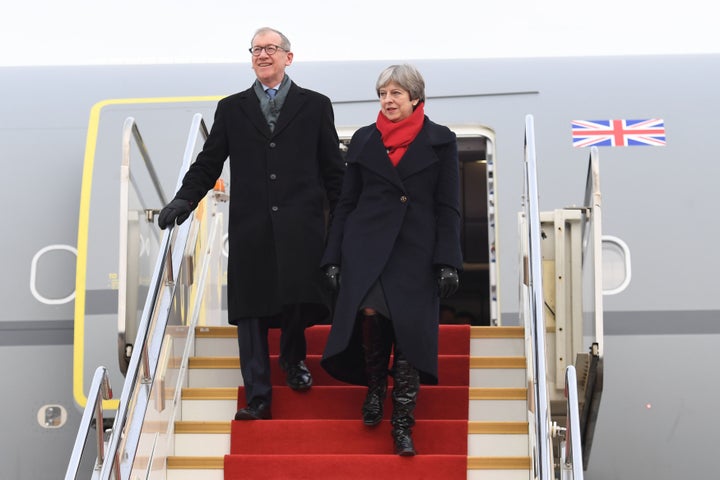
It was PMQs, but not as you know it. As her RAF Voyager jet cruised at an altitude of 35,000 ft, Theresa May was standing at the plane’s bar, taking queries from a hungry press pack.
A pile of black digital voice recorders and smartphones gathered before her like winking beetles, the Prime Minister gave a brief summary of the plans for her three-day trip to China.
But after the obligatory initial questions about trade and foreign relations with Beijing, the floodgates opened for the only issue many hacks wanted answers on: her leadership of the Tory party, or lack of it.
With her plainclothes security officers and phalanx of nervous media advisers looking on, more than two dozen reporters proceeded to grill May about her troubles back home.
Some of us stood on the business class seats to get a better view. Others strained their necks to hear her words above the aircraft’s hum.
As her flight had taken off, Brexit minister Steve Baker was still on his feet in the Commons, explaining why a leaked Whitehall document had revealed that every Brexit scenario would leave the UK worse off.
More worrying for No.10, speculation had been mounting that dissident MPs were close to getting the 48 letters needed to trigger a vote of no confidence in their leader.
Just as Margaret Thatcher was famously in Paris when her own premiership began to fall apart back in Westminster, some in her party felt that May’s trip to China offered a dangerous opportunity for the plotters. While the No10 cat was away, the mice could play, as one rebel had put it.
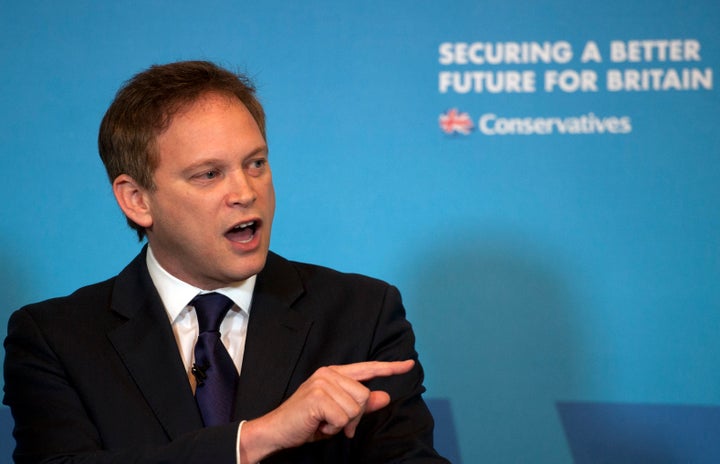
In the RAF Voyager’s functional business class suite, the BBC’s Laura Kuenssberg led the charge. “Are you confident that you will lead the Tory party into the next election? And is it up to you or your colleagues to make that decision?”
May replied with an oven-ready answer. “First and foremost, I’m serving my country, my party…I’m not a quitter and there’s a long term job to be done”.
She proceeded to trot out a list of what that ‘job’ entailed, with less than convincing lines about getting ‘the best Brexit’, stamp duty cuts and renaming the Department of Health to include the words ‘And Social Care’.
She talked about “a reduction in the attainment gap between rich and poor kids”, somehow managing to mix the vernacular with Whitehall-ese. She failed to mention the continuing earnings squeeze, or austerity, housing crisis for millions or NHS funding.
Occasionally, her gaze would flicker towards her official spokesman, as if checking her lines were following the script. Yet her determination to stay in post was striking, her mood defiant, her demeanour bullish. All the talk of motions of no confidence strangely seemed to have given her more, well, confidence.
For those MPs who simply think that the longer May remains leader, the more damage she does to the Tory brand, her central message – I’m not quitting, you should quit plotting - could help them goad waverers into joining the rebellion.
The last time the PM – on the same plane but on her way to Japan - had been asked if she wanted to fight the next election, she replied with an unequivocal “Yes”.
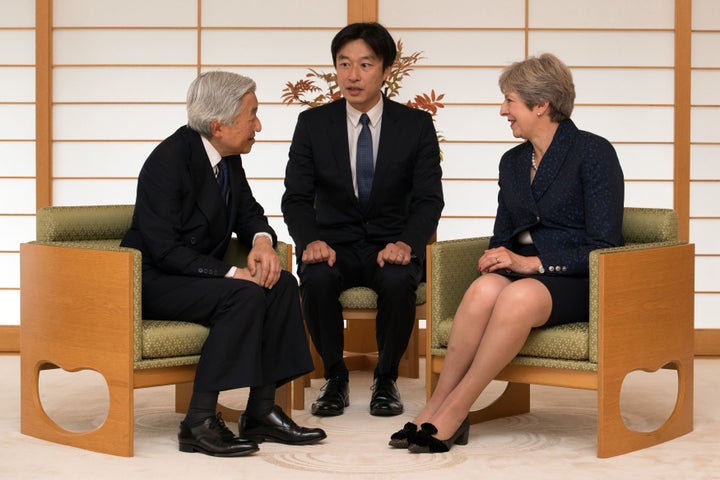
Perhaps overconfident that her challengers had not seized their moment after her humiliating 2017 general election, she surprised journalists by walking straight into the trap.
That answer sparked the trouble that has bubbled under ever since, famously spilling over after her disastrous Tory conference last September, when former party chairman Grant Shapps broke cover to call for her to go.
This time, she left herself some wriggle room, ducking a direct answer. But the key difference now is that the ratchet of the leadership letters threat is wound tighter. Back home in Blighty, rumours swirl that she is one more policy blunder, one more poor set of election results, away from a leadership challenge.
In the media huddle, May was pushed again and again on the mounting attacks from normally loyal backbenchers.
Perhaps the most surreal moment came when she was asked if she was a ‘tortoise’ or a ‘lion’ (former minister Rob Halfon had suggested she was the former on policy but needed to be the latter).
May replied with the inimitably awkward line: “I have never tried to compare myself to any animal, or bird or car or whatever sort of comparisons that sometimes people use.” It was as if someone had asked her if she’d rather fight a horse-sized duck or a hundred duck-sized horses.
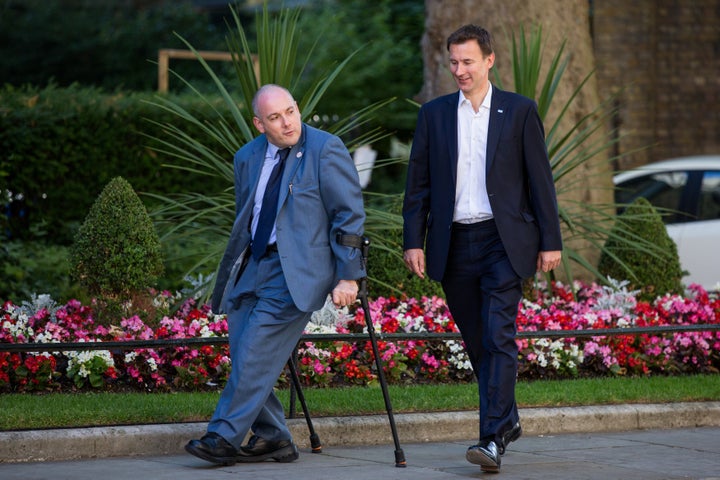
Would she stand and fight if a no confidence vote was triggered? “You always like talking about hypothetical situations. Let’s talk about where we are now and what we are doing now…”
Did she think Tory MPs were cowards for hiding behind anonymous letters urging her removal? “Look, the Conservative party leadership rules have been written and it’s a matter for the Conservative party, it’s always been written by the [backbench] 1922 [Committee]. They went through a long process in terms of writing those leadership rules.”
“So, you’re saying ‘write those letters if you like’?” HuffPost asked. “It’s a matter for the party,” she replied. “The rules that are set are a matter for the party.”
There was a glimmer of an admission that she had failed to communicate all the policies she was most proud of, as well a concession that more needed to be done and faster.
Yet when asked if she acknowledged she personally needs to do more to convince her colleagues that she was the right person to deliver on policy, the autopilot reappeared. “What I think is important for colleagues and for the public is actually what we’re doing as a government and what we’re achieving…”
It was the same on Trump, Brexit, immigration. Each time there was a straight bat that would make her beloved Geoffrey Boycott proud. The constant riff was that the key issue was presentation, not substance. Or her leadership. It’s not quite clear whether that excuse will still convince her MPs.
Still, by the end of the session, May’s aides looked relieved. There had been 25 minutes of questions (almost as much as the old PMQs in the Commons), and one official confessed that it was a new record for the PM. Her previous longest session with the media on a plane was 4 minutes shorter. A similar informal press conference on the way to Washington a year ago lasted just seven minutes in total.
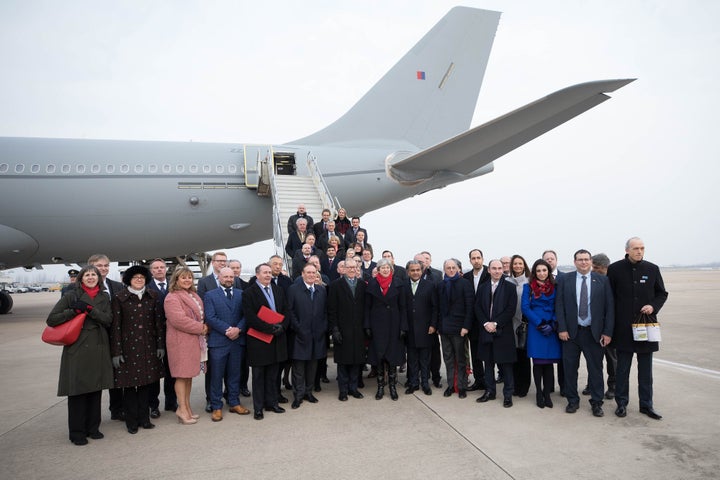
Part of the reason for her confidence may lie in the pre-briefing she had gone through beforehand. Insiders say that May has a very strict routine for foreign trips. She will spend the first hour on her ‘red box’ business first, reading in silence a thick dossier on the coming days’ talking points and policy.
Others around her normally join in the silence as they too cram the same stat-packed document, which can often only be available days or hours before. Seated at her side for the China flight were Gavin Barwell, her chief of staff since the election, and husband Philip, here for his first full foreign trip as a spouse.
After the departure of former joint chiefs of staff Fiona Hill and Nick Timothy – dubbed “the gruesome twosome” by their Whitehall enemies – the mood is noticeably less scratchy, sources say.
Some things have not changed, however. In keeping with her reputation for caution and meticulous preparation, once her red box is done, May will spend 45 minutes getting primed for her session with the media. Given that the media questions normally last only 15 minutes, that’s a ratio that resembles her three hours of PMQs prep each week.
Official spokesman James Slack is a former Daily Mail Political Editor, and well versed in sitting at the back, not the front, of the plane. In the prep session, he and others will often play the role of a reporter, probing the PM with tricky question in a dry-run of the Q&A ahead.
When she is finally ready, the curtains part from her first class section and May heads down to the bar for the media grilling.
Unlike David Cameron, who used to pad about and shoot the breeze with the media in his socks and pyjamas, May prefers a more formal approach. When she does sleep, it’s almost always behind a curtained section, away from even her closest staff.
Insiders say that one key factor that helps boost May’s mood is when she is on a plane packed with business people, rather than just politicians and the media.
“She’s much better when she can meet real people running real companies,” one old hand confided. “She asks them what they do, who they are meeting, and so on.”
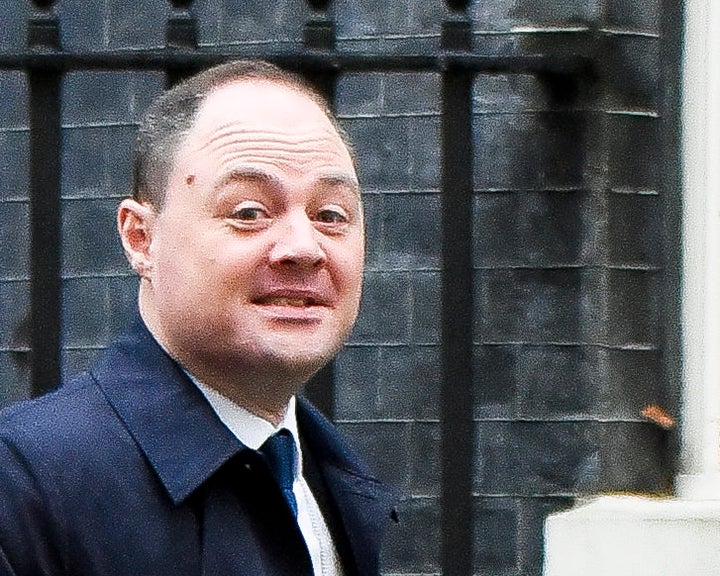
And on the flight to Wuhan, May made a clear effort to tour the plane and talk not just to those big companies and organisations in business class, but also the smaller firms travelling in economy with the assembled media delegation.
She spent at least 20 minutes chatting freely with them, showing a relaxed side rarely seen on camera. Many of those she chatted to were struck by how different her private image was from the public one. However, some confided that the trip suffered from a lack of advance notice that would have allowed them more meetings with counterparts in China.
Perhaps the most pleasure the PM gets on her ‘May Force One’ flights, however, is in talking to the RAF crew. On this trip, she walked up to the very back of the plane and chatted to a gaggle of attendants, the men wearing classic light blue shirts, the women white, on a rare break. One servicewoman was in khaki, another reminder that this is very much a military plane (in fact a converted refuelling jet).
In a vignette that her critics will find hard to believe, she actually made the whole RAF group erupt into peals of laughter, courtesy of a joke about them being able to ‘crash out’ when their 18-hour shift ended on landing (the crew are swapped over and can return home on a ‘civ’ or civilian flight). As well as tending to Prime Ministerial planes, the crew often man troop carrier flights and officers’ messes. All of them had praise for May.
After one particular trip to a ‘dry’ country, and all set for the journey home, she was once greeted by a friendly RAF attendant with the words: “Welcome to Great Britain, Prime Minister…Gin and tonic?”
The PM never drinks alcohol on the way out to foreign visits, and even on the way back only allows herself a G&T or glass of red wine once she has finished her new ‘red box’ of domestic duties awaiting her back home.
She has three more days of this trip, and a lot of Chinese protocol ahead, before that homeward drink beckons.
Whether her defiant answers in the on-board PMQs will be enough to satisfy her restless backbenches is itself the remaining unanswered question.
